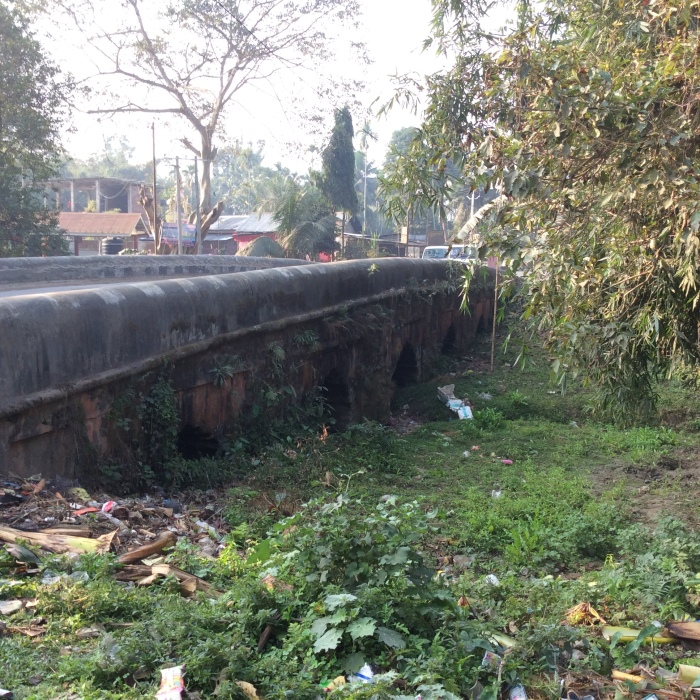The drive to Sibsagar (also known as Sivasagar) from Jorhat in Assam takes about an hour. Except for one small stretch, the road, which is the National Highway 37, is smooth and and makes for a beautiful drive. The entire stretch is lined with banana and coconut trees and cottages with cane around them making for a pretty sight. It is almost impossible to take one’s eyes off the beauty all around.
But there is one place along the drive, about 15 km before Sibsagar and at a place called Gaurisagar, when you have focus on something else, even get off the vehicle you are travelling in. It is a bridge across the river Namdang, a tributary of the river Dikhou. The bridge is a small, not a particularly impressive looking, one and is about 60 m in length and 7 m in width.
But don’t go by its looks, for this bridge is only one of 10 such bridges ever built in Assam that still survives today. It is a Sila Saku or a stone bridge that was built in 1703 by the Ahom King under whom the dynasty reached its zenith, Swargdeo Rudra Singha.

The Ahoms were prolific builders and under the rule of Rudra Singha, the kingdm’s infrastructure and connectivity was enhanced. He built 10 such Sila Sokus in Assam for which he got stone masons from neighbouring Bengal. The bridge was constructed using flat or globular stones or cobbles (collected from river beds) and bricks, which were cemented using an organic mix of fish, egg, molasses, pulses, rice and lime, among others ‘ingredients. The top of the bridge is curved and engineered to take the ever increasing load of traffic that passes over it every day.
 The top of the bridge is supposed to have been made from a single piece of stone. The arches are also said to have beautiful sculptures carved on them. I got to know about the sculptures only after my visit and even if I had been aware of the sculptures I doubt if I could have seen them. You see, there a big pile of rubbish and what not that I would have had to navigate to reach the arches.
The top of the bridge is supposed to have been made from a single piece of stone. The arches are also said to have beautiful sculptures carved on them. I got to know about the sculptures only after my visit and even if I had been aware of the sculptures I doubt if I could have seen them. You see, there a big pile of rubbish and what not that I would have had to navigate to reach the arches.
It is remarkable that a bridge of that age, built with local technology and techniques has rarely seen any repairs, and is still standing strong. The Namdang Sila Soku is a precious heritage, not only of Assam but also of the nation and deserves more than the passing mention that is given to it now. It deserves to be better looked after and cared for.
The Namdang Sila Soku was the first of the Ahom era structures that I saw during my recent visit to Assam and also my introduction to their historical legacy and heritage. In the coming weeks, I will be writing more about the Ahoms and the kingdom they once ruled. Watch this space ! 🙂
For more in the “Travel Shot” series, click here.
Join me on Twitter, Facebook and Instagram as I explore the world around me and share “My Favourite Things” with you.

Interesting and I’m looking forward to more posts on Assam
LikeLiked by 2 people
Thank you, Sushmita. The Assam posts will take a while to be posted here as there are two previous trips still to be written – Jhalawar and Kanchipuram. Hopefully, I’ll finish writing both these series soon. Fingers Crossed
LikeLike
How strong that bridge is ! And there’s a Flyover opposite Oberoi Mall in Goregaon which needs amendments after just 5 years of construction!
LikeLiked by 1 person
That is the state of construction today ! I don’t know if it is a lack of sincereity or lack of availabilitty of quality material or cost cutting or a combination of all these and more that makes modern day constructions so short-lived. The worst is we accept it and even expect that it will not last beyond 10 -15 years.
I wish we don’t have to express surprise on old structures that are still going strong today. Instead, longevity of structures should be taken as a given and short-lived contructions questioned.
LikeLike
I could visualize the description of your travel and those guys were ahead of their times in constructing the bridge standing tall through the materials used. Enjoyed reading the history behind, too.
LikeLiked by 1 person
Thank you, Vishal. I’m always amused when I read about modern day people wondering how structures were built without modern day technology. They don’t realise that it is a technology that we don’t understand or have lost, and today’s technology is geared for rebuilding periodically, rather than for longevity.
LikeLiked by 1 person
Are you earning with this blog?
If you dont mind to tell.
LikeLike
No, I’m not. However, those posts which were based on invites or product reviews mentions it in the disclaimer.
LikeLike